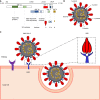Dysregulated liver function in SARS-CoV-2 infection: Current understanding and perspectives
- PMID: 34366609
- PMCID: PMC8316914
- DOI: 10.3748/wjg.v27.i27.4358
Dysregulated liver function in SARS-CoV-2 infection: Current understanding and perspectives
Abstract
Since it was first reported in December 2019, severe acute respiratory syndrome coronavirus 2 (SARS-CoV-2) infection has spread rapidly around the world to cause the ongoing pandemic. Although the clinical manifestations of SARS-CoV-2 infection are predominantly in the respiratory system, liver enzyme abnormalities exist in around half of the cases, which indicate liver injury, and raise clinical concern. At present, there is no consensus whether the liver injury is directly caused by viral replication in the liver tissue or indirectly by the systemic inflammatory response. This review aims to summarize the clinical manifestations and to explore the underlying mechanisms of liver dysfunction in patients with SARS-CoV-2 infection.
Keywords: COVID-19; Cytokine storm; Dysregulated liver function; SARS-CoV-2.
©The Author(s) 2021. Published by Baishideng Publishing Group Inc. All rights reserved.
Conflict of interest statement
Conflict-of-interest statement: There are no conflicts of interest to declare.
Figures


Similar articles
-
COVID-19: from the structure and replication cycle of SARS-CoV-2 to its disease symptoms and treatment.J Physiol Pharmacol. 2021 Aug;72(4). doi: 10.26402/jpp.2021.4.01. Epub 2021 Dec 31. J Physiol Pharmacol. 2021. PMID: 34987123 Review.
-
Severe Acute Respiratory Syndrome Coronavirus 2 Impact on the Central Nervous System: Are Astrocytes and Microglia Main Players or Merely Bystanders?ASN Neuro. 2020 Jan-Dec;12:1759091420954960. doi: 10.1177/1759091420954960. ASN Neuro. 2020. PMID: 32878468 Free PMC article. Review.
-
SARS-CoV-2 infection of the liver directly contributes to hepatic impairment in patients with COVID-19.J Hepatol. 2020 Oct;73(4):807-816. doi: 10.1016/j.jhep.2020.05.002. Epub 2020 May 11. J Hepatol. 2020. PMID: 32437830 Free PMC article.
-
Replication of Severe Acute Respiratory Syndrome Coronavirus 2 in Human Respiratory Epithelium.J Virol. 2020 Jul 16;94(15):e00957-20. doi: 10.1128/JVI.00957-20. Print 2020 Jul 16. J Virol. 2020. PMID: 32434888 Free PMC article.
-
COVID-19 and liver injury: An ongoing challenge.World J Gastroenterol. 2023 Jan 14;29(2):257-271. doi: 10.3748/wjg.v29.i2.257. World J Gastroenterol. 2023. PMID: 36687117 Free PMC article. Review.
Cited by
-
Liver Injury in COVID-19 Patients with Drugs as Causatives: A Systematic Review of 996 DILI Cases Published 2020/2021 Based on RUCAM as Causality Assessment Method.Int J Mol Sci. 2022 Apr 27;23(9):4828. doi: 10.3390/ijms23094828. Int J Mol Sci. 2022. PMID: 35563242 Free PMC article.
-
Acute liver injury in COVID-19 patients hospitalized in the intensive care unit: Narrative review.World J Gastroenterol. 2022 Dec 21;28(47):6662-6688. doi: 10.3748/wjg.v28.i47.6662. World J Gastroenterol. 2022. PMID: 36620339 Free PMC article. Review.
-
Liver function in transgender persons: Challenges in the COVID-19 era.World J Clin Cases. 2023 Jan 16;11(2):299-307. doi: 10.12998/wjcc.v11.i2.299. World J Clin Cases. 2023. PMID: 36686345 Free PMC article. Review.
-
Liver Damage Associated with SARS-CoV-2 Infection-Myth or Reality?J Pers Med. 2023 Feb 17;13(2):349. doi: 10.3390/jpm13020349. J Pers Med. 2023. PMID: 36836583 Free PMC article.
-
Strategy for the control of drug-induced liver injury due to investigational treatments/drugs for COVID-19.World J Gastroenterol. 2021 Dec 28;27(48):8370-8373. doi: 10.3748/wjg.v27.i48.8370. World J Gastroenterol. 2021. PMID: 35068875 Free PMC article.
References
-
- Epidemiology Working Group for NCIP Epidemic Response. Chinese Center for Disease Control and Prevention. [The epidemiological characteristics of an outbreak of 2019 novel coronavirus diseases (COVID-19) in China] Zhonghua Liu Xing Bing Xue Za Zhi. 2020;41:145–151. - PubMed
-
- Huang C, Wang Y, Li X, Ren L, Zhao J, Hu Y, Zhang L, Fan G, Xu J, Gu X, Cheng Z, Yu T, Xia J, Wei Y, Wu W, Xie X, Yin W, Li H, Liu M, Xiao Y, Gao H, Guo L, Xie J, Wang G, Jiang R, Gao Z, Jin Q, Wang J, Cao B. Clinical features of patients infected with 2019 novel coronavirus in Wuhan, China. Lancet. 2020;395:497–506. - PMC - PubMed
Publication types
MeSH terms
LinkOut - more resources
Full Text Sources
Medical
Miscellaneous

